-
-
Accédez au logiciel étudiant gratuit
Ansys donne les moyens à la prochaine génération d'ingénieurs
Les étudiants ont accès gratuitement à un logiciel de simulation de classe mondiale.
-
Connectez-vous avec Ansys maintenant !
Concevez votre avenir
Connectez-vous à Ansys pour découvrir comment la simulation peut alimenter votre prochaine percée.
Pays et régions
Espace client
Support
Communautés partenaires
Contacter le service commercial
Pour les États-Unis et le Canada
S'inscrire
Essais gratuits
Produits & Services
Apprendre
À propos d'Ansys
Back
Produits & Services
Back
Apprendre
Ansys donne les moyens à la prochaine génération d'ingénieurs
Les étudiants ont accès gratuitement à un logiciel de simulation de classe mondiale.
Back
À propos d'Ansys
Concevez votre avenir
Connectez-vous à Ansys pour découvrir comment la simulation peut alimenter votre prochaine percée.
Espace client
Support
Communautés partenaires
Contacter le service commercial
Pour les États-Unis et le Canada
S'inscrire
Essais gratuits
ANSYS BLOG
May 19, 2023
Supported by Ansys, HSD Mechatronics Puts a New Spin on Product Innovation
You might not know what an electrospindle is, but you’ve probably driven a car or flown in a plane that was manufactured using these advanced devices. A key production component in the automation and mechatronics sectors, electrospindles are machine tools with rotating shafts that support cutting, grinding, milling, and other processes. These hardworking tools are designed to machine metal, wood, composite materials, glass, and stone.
HSD Mechatronics, based in Italy, is the world’s second-largest manufacturer of electrospindles. It also produces two- and five-axis heads, boring heads, rotating tables, smart motors, and other machine components. HSD provides these solutions — many of which are highly customized — to customers in the automotive, aerospace, industrial manufacturing, construction, defense, and other industries.
While electrospindles and related tools must operate with incredible levels of precision, they are also subject to extremely demanding conditions, including high-speed mechanical rotation and high thermal loads. According to HSD Prototypes, Tests, and Experiences Manager Manuel Camperchioli, delivering that combination of precision and durability has always been a primary focus for the company’s product development team.
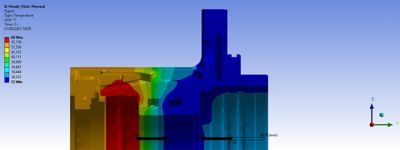
Thermal effects and deformation are serious concerns for key components of electrospindles, such as this flange. Ansys helps HSD study and eliminate these types of performance issues to arrive at next-generation product designs.
“Many of our customers are original equipment manufacturers who must meet strict quality standards and tight production deadlines,” says Camperchioli. “That means we must engineer our solutions, including electrospindles, for maximum performance, power density, durability, and consistency over time. We need to understand and minimize materials degradation, vibration, thermal buildup, and other physical issues that impact long-term, reliable performance in our customers’ applications.”
Since 2019, HSD has relied on a suite of Ansys solutions, including Ansys Mechanical and Ansys Fluent, to simulate the real-world performance of its electrospindles in customer applications and investigate improvements such as new materials. HSD has chosen an Ansys Cloud delivery model that Lorenzo Ciccarone, Electrical Machines Designer at HSD, notes has been critical in managing the large numeric problem sizes required to replicate rotating machinery.
“Accessing Ansys software on Ansys Cloud allows our engineers to utilize many more computing cores and many more processors working in parallel,” Ciccarone says. “Large multiphysics problems like vibration can be distributed and solved much faster. In fact, we’ve achieved a 40X acceleration in solution times since we transitioned from using an internal cluster to the Ansys Cloud delivery model. That enables us to run many more simulations and investigate more complex performance issues.”
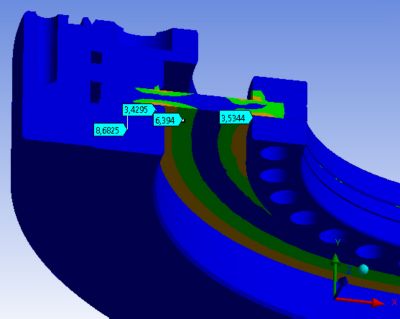
The HSD engineering team used Ansys Mechanical to analyze structural fatigue in a rotor braking system.
The other benefits of partnering with Ansys on electrospindle optimization since 2019 include decreased development costs and reduced human labor requirements, which have been increasingly important due to engineering talent shortages.
Developing the Electrospindle of the Future
But that’s only the beginning of the story. In December 2020, HSD was named a partner in Italy’s prestigious Intelligent Factory Cluster, a public-private partnership aimed at establishing Italian leadership in zero-defect manufacturing. HSD has set its sights on developing a next-generation electrospindle that is digitally connected to the rest of its customers’ production environments. The Polytechnic University of Marche, Sapienza University of Rome, and startup company EN4 are partners in the ambitious development project, called “Electrospindle 4.0.”
“The electrospindle of the future will be digitally connected, in real time, with the rest of the factory to create a true zero-defect environment,” says Marco Apuzzo, Competence Center Electric Motor Design Manager in R&D Mechatronics at HSD. “By connecting all their production assets, including machine tools, manufacturers can create a centralized digital control tower that can detect defects at any stage of fabrication and assembly.
"Through the open sharing of data, expertise, and information across all production functions, a win-win situation is created for both HSD and its customers,” Apuzzo says. “Every partner can create dramatic product innovations and introduce new best practices that take manufacturing to the next level.”
To accomplish the ambitious goals of Electrospindle 4.0, HSD partnered with Ansys to add Ansys Twin Builder to its solutions portfolio.
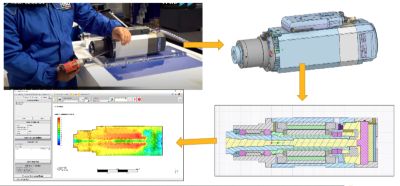
The goal of the Electrospindle 4.0 project is to create a digital twin that’s directly connected to a working machine tool. Simulation via Ansys can identify and predict any issues before they impact the performance of the physical electrospindle.
Why Twin Builder? Increasing the interconnectivity of its machine tools with the larger production environment means HSD must place sensors on each electrospindle. Some of these are real-time physical sensors that warn of an event or the need for a service call. But it’s impossible to place physical sensors everywhere they’re needed due to the complexities of electrospindle operation. So, an equally important component of Electrospindle 4.0 is creating an accurate digital twin of the working tool that’s equipped with a series of virtual sensors. That’s where Twin Builder comes in.
“We can replicate a specific tool’s operating conditions in Twin Builder based on live inputs from the digitally connected, working electrospindle — then the virtual model provides even more data points,” says Ciccarone. “By gathering data from both physical and virtual sensors, we can predict repair and maintenance needs before an event happens. We can gather an enormous amount of real-time insights to continuously optimize the product and its performance. Ansys Twin Builder is the perfect solution for building that working model of the electrospindle and connecting it to the live, working tool in a customer’s facility.”
Complementing physical sensors with virtual sensors reduces the overall costs of digitalization and enables HSD to explore very complex performance parameters — such as the internal workings of the tool — that would not otherwise be possible. While creating real-time connectivity across the factory is still a complex undertaking, the use of Twin Builder is helping to simplify it, accelerate the overall development process, and drive down the costs of the Electrospindle 4.0 initiative.
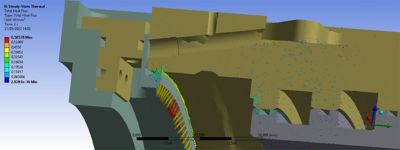
Heat flux distribution on an electrospindle flange
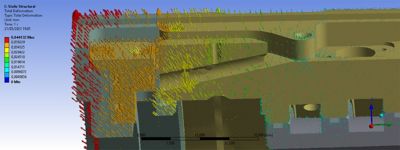
Thermal and deformation analysis on electrospindle flange
HSD and Ansys: Partners in Extreme Innovation
Looking ahead, HSD plans to continue using simulation to increase the use of automation, along with robots or co-bots, in its future product designs. While the company is an established leader in electrospindles and other machining tools, it’s committed to launching ongoing and dramatic product innovations that change the industry. Ansys is a strategic partner in that effort.
“We chose to partner with Ansys because it’s the best and biggest provider of simulation software with the greatest knowledge and the broadest capabilities,” says Camperchioli. “From the cloud delivery model and the support team here in Italy to the multiphysics software portfolio, Ansys has been able to meet all our needs.”
“Developing the electrospindle of the future is really about applying advanced technologies and real-time connectivity to eliminate defects, improve product quality, speed up production, and reduce human labor requirements to the greatest extent possible,” Apuzzo says. “Our customers are facing greater and greater demands, and we need to respond with greater and greater innovation. Ansys is helping us deliver that extreme level of innovation.”
See how Ansys Twin Builder can help you.